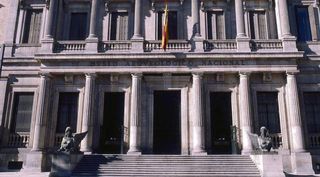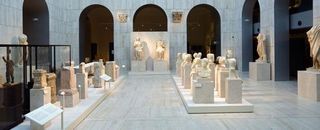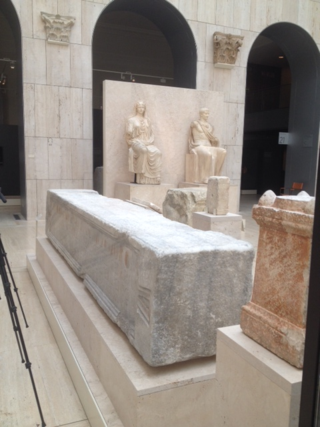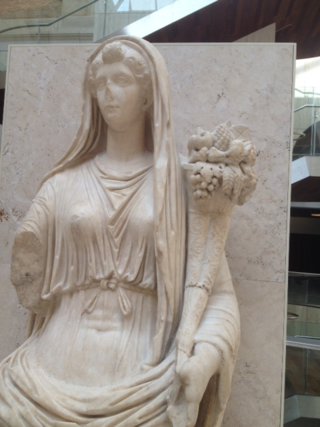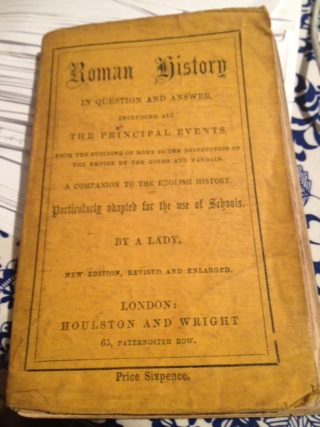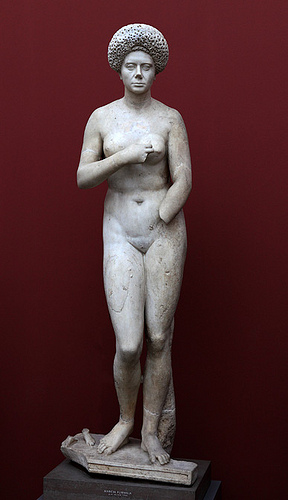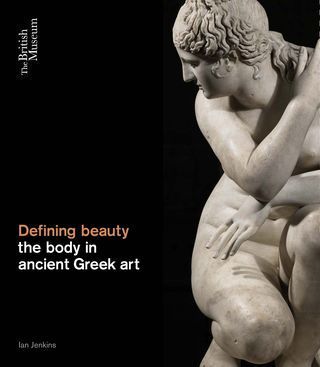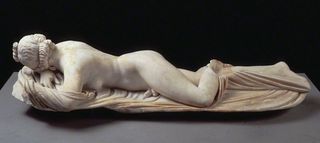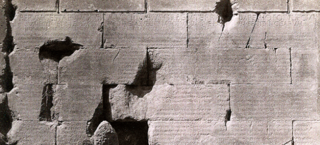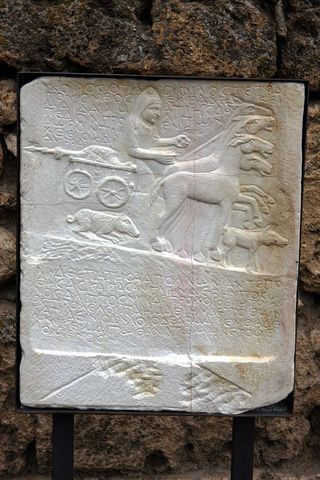Mary Beard's Blog, page 25
April 15, 2015
How to vote?
I should warn you that, in between reflecting on Spain, I am going to be having a few words to say about the Party Manifestos, hundreds of pages that I haven't had a chance to read yet, but have started and will finish.
At this minute , I am ploughing through them all, starting with Labour.
My first reaction is that all parties are trying to legislate too much, that they have equated good government with legislation. One response would be that they need to put everything they possibly can in their manifesto, as that protects them from an ambush from the House of Lords somewhere down the line (as I understand it, the Lords cant oppose plans in the ruling party's manifesto).
But honestly, the Labour manifesto is more than 80 pages, including quite a few pictures, and we do wonder who reads it and what it amounts to, and whether all this legislation is necessary to get to the goals they want. (I mean do we really want to guarantee that anyone gets a GP appointment in 48 hours.. i mean maybe some GP surgeries know that some people dont need that..)
And an awful lot of muddle creeps in.
Of course, I looked first for the things that impacted on me. Here was one:
"We will create a Prime Minister’s Committee on the Arts, Culture and Creative Industries, with a membership drawn from all sectors and regions. The Committee will bring issues of concern direct to the attention of the Prime Minister."|
Fine I thought, but what exactly is that? Who are the sectors and regions, and how exactly will their concerns come to the PMs attention? And who will these people be?
And if I were to vote Labour, I would need to know more than that they were backing a replacement for the Lords in the shape of " an elected Senate of the Nations and Regions, to represent every part of the United Kingdom,and to improve the democratic legitimacy of the second chamber". So how was the election to be conducted, amongst whom and by what system? I find it in principle hard to sign up to a non elected second chamber, but I do think that, when people are more and more worried about the elected professional political class, it is odd that they try to give it more power. I challenge anyone to say that people like cross benchers Martin Rees and Onora O'Neill and Patrick Hennessy are not among the jewels of the House of Lords. Would any one of them stand in a party political electoral system? Bet not.
I have to say that I also missed in the Labour Manifesto any sense that what I did, as a cultural worker, was any kind of contribution to the national good at all. I got the feeling that I was the icing on the cake, not someone earning money by cultural work (if money is your criterion). Where is their calculation I wondered about how much cash came into this country thanks to the efforts of people like me..foreign students, the underpinning of movies and west-end plays etc etc.
Many of the others manifestos are worse, and I shall come to them in due course. This is just a first gnaw at the first out.
April 11, 2015
Discovering the National Archaeological Museum in Madrid
Thanks to everyone with suggestions about Spain (and especially thanks to the top off that the Senatus Consultum de Pisone may not be on display, which caused a change of plan from the Seville Archeological Museum). I did however get to the Museum in Madrid, which has recently had a wonderful make-over. The classical collections look truly amazing .. well worth a detour as Mr Michelin might say.
This gives something of the general flavour and style of the place.
There's loads of space, neatly combined with a nice sense of proximity (between sculptures, and between sculpture and viewer). And there are also some stunning, and if not stunning then interesting, individual pieces.
I was particularly keen on this pair of Livia and her son, the reputedly morose Tiberius. Here he is seen as heroically nude, and youthful, at least down to the waist. As a pair, it is a good case of how sculpture tries to underwrite dynasty in the dynamics of Julio Claudian succession.
This Livia too.. on her own, as the goddess Ceres -- was quite an eyeful. And a wonderful example of the vision of imperial power in divine terms,
And to be honest I had never seen anything quite like this, a bronze Attis, with amazing inlaid trousers (sorry he is behind glass, but I think you get the picture).
But most extraordinary of all were the late nineteenth, early twentieth century sphinxes that guarded what used to be the main front door of the museum. As a welcome to the riddles of what lies inside any museum they can hardly be beaten, but it woud be hard to deny that they are a trifle disturbing.
But do go see.
April 9, 2015
Hispania Romana
I am just about to make a flying visit to Spain, to see some Roman things. Roman Iberia (just so you know that I am not forgetting Portugal) is a place I know much less well than Italy. My excuse is that when I was a backpacking student, we lefties didn't visit General Franco's abode. (I think that we weren't supposed to visit Greece either, but I am not quite so sure we stuck to that as firmly . . .)
My best visit was more than 10 years ago now, when I went to a conference in Huelva with my colleagues, Christopher Kelly and the much missed Keith Hopkins, and when the official bits had finished we hired a car and went a bit nerdishly around Roman things (Keith at that time was very into "Roman production" so we spent a long time at the Rio Tinto mines, I recall).
The truth is that there is not only loads more to see there (Segovia aqueduct being a prime example), but that Spain has actually been one of the most important places for new Roman discoveries in the last few years. In the post-Franco period, new inscriptions have just flooded out. Perhaps the most intriguing, but it is only one of many, is the bronze inscribed text of the Senatus Consultum De Gnaeo Pisone Patre - the senate's judgement on the man (Gnaeus Calpurnius Piso) who supposedly, if you believe Tacitus, had hand a major hand in the mysterious death of the glamorous prince Germanicus in 19 AD.
Piso, who had been governor of Syria when Germanicus died, had already killed himself by the time the senate had come to their conclusions. They are (to say the least) extremely down on Piso, but they appear, by implication, to let him off the charge of murder; in fact, it is not even clear from the inscribed text that he had ever been formally charged on that score. And they are also very keen to make it clear that the reigning emperor Tiberius and his mother Livia had nothing whatsoever to do with death either.
It is all wonderfully different from Tacitus' account (his description of the trial is here, and the run-up events can be found from the end of Annals Book 2). That is not to say that the senate's version is correct, they may be just as biased their own way as Tacitus -- but it is one of those few cases where we can hold up an inscribed text against an account of the same incident in a Roman historian (the speech of the emperor Claudius advocating the admission of Gauls to the senate is another, or the Bacchanalian scandal in 186 BC yet another -- in each case there are significant differences).
Anyway, I hope to take a peek at this document (it's in the Museum at Seville), as well as plenty more. Any suggestions on what I should see? I'll be reporting back.
April 4, 2015
Roman History -- by a lady
The son bought me a great little present from the Oxfam shop today. For a mere 4 quid, he acquired "Roman History in question and answer . . . including all the principal events . . . particularly adapted for the use of schools, BY A LADY" (revised edition 1864).
It is a gem, organised in 306 individual questions, from "Where was the city of Rome situated?" (answer "On the banks of the river Tiber") to "Did the Turks succeed?". We are taking the 15th century here, and it is interesting that it take "Roman History to the Fall of Constantinople. (answer "They did; and after a long and sanguinary battle, in which Constantine was killed, defending his city, the capital of the East was taken in 1453; the Turks admitted into Europe; and having endured for 1,123 years, the Eastern half of the Roman Empire ceased to exist").
it is one of those texts which take you into the world of non-elite (or at least non male elite) Classics in the nineteenth century, and helps you see what it was like behind the nineteenth-century school desk...all those kids trying desperately to mug up the phrase "long and sanguinary battle").
But it's also fun trying to work out who owned it. This one has the name "Annie E Dudley" written on the title page, and then underneath "L A Dallas", as presumably the later owner. It would have been great to imagine that this was something to do with Anne Dallas Dudley the American suffrage activist, but there's no reason to suppose that the book has ever been out of the country, and Anne Dudley doesn't seem to have had E as a middle initial. So that is probably a non-starter.
On the same Oxfam haul, the son also picked up a beautifully bound copy of the "Egypt Order in Council" of 1937, with "HBM Consul General" on the title page... now he presumably IS identifiable.
April 3, 2015
The great debate
As I have said before , I am not much of a fan of TV prime-ministerial debates. I can't stand the learned-up lines, the desperate attempts to get in the "killer point", the sound bites emerging as if they were natural, and the false bon homie with questioners ("I see exactly where you are coming from John".. uggh). It always seems to me as if it is a load of lambs to the slaughter, and the only question is who dies first -- when actually governing the country requires a whole load of very different skills, not on display in this stuff.
The one thing that makes me think about changing my mind is that over 7 million people watched last night (including me), which I guess is a kind of democratic engagement which can't be ignored. And it has been a prompt to talking about the looming election.
It still didn't seem to me much about real discussion. When one heckler started heckling, they were quickly removed from the sound system -- which didn't seem like free political debate to me (aren't hustings all about heckling?). And for the most part we only got the usual soundbites from the usual suspects, and the usual confirmation of existing opinions.
As I watched (and I should have been ploughing on with chapter 10), I thought Farage was simply banging on about the same narrow set of issues that define UKIP (basically xenophobia). But it was clear that some people in the world thought he had done brilliantly -- despite what he said about grammar schools and HIV. (How many times does anyone have to say that grammar schools did help a few, had great teachers etc, but overall were NOT a vehicle for social mobility?)
Meanwhile, I was impressed with Nicola Sturgeon (but wished she wasn't a nationalist.. come on Nicola, you can help get rid of food banks from across this green and pleasant land, not just Scotland), and with the women in general.
So I remain not much of a fan of the debate format. And I am certainly not much interested to know who was deemed to have "won". Outside the "Oxbridge Union" style of debating, debates are not actually about "winning", they are about exposing and reflecting on the issues . . .
Maybe the whole lot will be more interesting when Cameron isn't there. He and Miliband were both a bit hard to take.
As the husband says, we are not looking for a President, we are looking for a chair of UK government. I couldn't give a toss if Miliband is a "leader", or if he can give a well prepared answer to a TV question. I am interested in whether the front bench team on either side has an executive and democratic grip.
That's more than saying "yes John" to a questioner on a tv debate.
March 29, 2015
On not managing Lent
I am going to confess before I am rumbled that I have not managed more that half Lent this year. That is I guess three weeks. There is no real excuse, I do admit. But to be honest abstinence did not fit in any way with the end of the book.
I am now on Chapter 10 and so really am on the home straight. But Chapter 9 was one hell of a struggle. It covers the death of Caesar to the death of Augustus, on which I have a lot of ideas. But it is amazing how easy it is to become boring about Augustus. I found myself writing a few pages one day, then looking at them in the evening or the next day and facing the awful truth that they were just boring.
Now I dont for one minute imagine that every page of a history of Rome should be a sparky, witty, up front read. Far from it. There is some tough stuff which it would be dishonest to pretend otherwise was tough. But that isn't quite the same as being boring. I mean the army reforms of Augustus are crucial and revolutionary. They nationalise the Roman army for the first time ever... but they do need to "sing" as well as giving the facts. Why is this so revolutionary etc? Why should you bothered to be interested?
Anyway, to be honest the absence of alcohol did get to be counterproductive. If I had a good day, I tended to go on working till 2.00 in the morning, getter tireder but not sleepy, and generally less productive in any way. If I had a bad day, I got crosser and crosser, still stayed up all night and then went to bed (I am told) muttering about the chapter all night, in the the wee small hours
Eventually the husband pointed out that, much as he shared our desire to abstain for 6 weeks for all the obvious reasons, it may be counter productive when finishing a book. Or, frankly, if he had to live with me during this struggle, and not a drop to be consumed, it might .. well ... be difficult.
So after three weeks of not a dropI bought myself off, and will take a couple of weeks off the demon when the book is finished.
March 26, 2015
Marcia Furnilla
I am responding here to a request for a bit more information about the statue of Marcia Furnilla. I mean the so-called "Marcia Furnilla" -- MF was the second wife of the emperor Titus but, although the hairdo makes this about the right date, there is no reason to suppose that this is her.
She comes from Rome, is housed in the Ny Carlsberg Glyptotek in Copenhagen, and is currently in the Defining Beauty exhibition at the British Museum. I have talked to students about her for more than thirty years. I have to say that when I was young, I used to encourage them to be very sniffy about this. I would say... look this is some idiot patron/sculptor who just doesnt "get" what the basic issue about ancient beauty norms are.
But I was wrong I think.
Two things on this really.
First, the incongruity of the middle-aged head on the Venus body is far less incongruous in real life than it is in the stil pictures. When I was involved in the Royal Academy show of the Ny Carlsberg sculpture some 10 years ago, we brought her to London, and actually she is much less "odd" when you see her "in the flesh". It's a good case of the need to look at things in real life,
But that is not the biggest point. What the "Defining Beauty" exhibition shows is that sculptures like this are really pushing away at the normative ideas of Greek beauty, and that there are big questions ancient sculptors are raising about beauty. Whoever made this sculpture, he (I assume a he) is surely asking about the relationship between age and desire... he is not taking the piss out of elderly ladies, he is asking about what the relationship is between Venus young and Venus old. He is asking us to challenge our own view of classical beauty... can you put an old head on young shoulders?
What do you think?
March 22, 2015
Defining Beauty
I am off to the launch of the new British Museum exhibition, Defining Beauty, later this week (and I shall be singing for my supper as you will see in due course).
It is all about the BODY in Greek (and Roman) art ... more of it Roman than one would think no doubt, but we Romanists have got used to having Roman art overlooked.
It has I believe a stunning selection of loans, including the Belvedere Torso and the Sleeping Hermaphrodite (the one from Rome I think).
The question is for me: what is the Greek BODY all about? And what should we be discussing.
Overall my sense is that "we" (I mean people in general, including me) have gone far too far down the idea of the image of the classical Greek body as "normative", which indeed it has become. This is now how western bodies are supposed to be. But what I see here in the preview of the catalogue that I have had is something much more complicated.
It seems to me that the whole ancient Greek "body project" is much more uncertain and provisional than the normative image that some of us take for granted (and some of us hate) would suggest. The point is much more that ancient sculptors were trying to reach some version of representing the human form that could seem true in a world in which (like our own) the whole idea of the body was up for grabs, contested, difficult and disputed.
What else is the amazing hermaphrodite (above) for, if not to make it awkward to think about simply gendered human bodies, and to wonder about sexual difference?
To put this another way, would it not be better if we remember that ancient Greeks were not laying down the law about how ancient bodies SHOULD be, but were wondering about bodily and sexual difference in sculpture... much more a message for us?
March 20, 2015
Augustus' Res Gestae
Thank you all for your help with the pig tombstone. Now I have been pressing on with the home straight of the book. We are now into the imperial period (ie we have hit Augustus) and you have to do this stretch slightly differently from what went before. It would of course be possible to go through the early principate, emperor by emperor, but the question would be cui bono? In the end the basic principle of Roman imperial rule remains, good rulers and bad rulers, for a couple of hundred years, and no particular heinous crime or virtuous rule makes much difference, except at the margins. I am trying to think how to do it instead, and how to think what the issue are, rather than the people.
And Augustus, first emperor (unless you count Pompey or Julius Caesar -- a big "unless" if you ask me), must be crucial, and that's where I am.The ancient tradition on Augustus is to be honest confusing, from founding father of the Roman imperial regime (and on some views the only "good" emperor), to rank hypocrite who dressed up a bloody tyranny in the cloak of a restored Republic. That's not just a disagreement between friends and enemies, but is rooted in bigger disagreements on what the whole rule was all about.
My problem has been exactly where to start, and I have tried all kinds of different kick off points over the last few days. My first idea was to go from the disagreements that Tacitus reports as being aired at Augustus' funeral: loved by some as a moderate ruler, hated by others as a butcher who had not really changed his spots since the civil war.
But somehow, this all got to feel terribly "meta" -- I mean a perspective from 100 years too late.
So in the end (after a bit of internal conflict -- you always have internal conflict when you have to change your mind) I followed the advice of a couple of friends and decided that I had to go for the words of Augustus himself straight away, and kick off with his Res Gestae (his inscribed, autobiographical cv, illustrated above), and with what he SAID he did.
I had been teaching this text a bit this last term, but reading it over very quickly again, it was just so striking how narrowly it defined the functions of Roman imperial power as being Conquest, Building and Benefaction -- combined with the ability to provide an account of that power, which it is hard to think of anyone but possibly Julius Caesar being able to do before.
To put it another way, the litany of facts and figures in the Res Gestae,from the number of Roman citizens to the exact amount of Augustus' benefactions to his people, seems to me to hit the nail on the imperial head -- and to sum up one-man autocratic rule as much as a control of facts and of knowledge as of people themselves. The stunning fact about Augustus is that he can LIST all this.
I am late to the party here. We had a great Part II course in Cambridge a few years ago called "Power and Knowledge", which looked at the intellectual impact of imperial power (on Geography, Science, Medicine etc). I enjoyed this course and could talk the talk pretty well. But it was really only rereading the Res Gestae in a quick half hour that I really got the point, and saw what a KNOWLEDGEABLE text this was.
March 15, 2015
The pig's epitaph
In the Roman Popular Culture course that I coordinate with Jerry Toner in Cambridge, we have been spending a bit of time thinking (a) about the role of pigs in popular culture (the famous Testamentum Porcelli being a great example, the spoof last will and testament of a pig called Marcus Grunter Corocotta, and well known to St Jerome as a text that made school kids hoot with laughter, and (b) about the role of the Roman epitaph and tomb design as part of non-elite self-representation in the Roman world (for example the so-called Tomb of the Baker or the bit in Petronius' Satyricon where Trimalchio gets down to his tomb design, chap. 70-71 here).
Anyway, we had a good 'show and tell' session in the last class of term, and one of the students brought along something that I confess I had not seen before, and about which I thought some of you might have some ideas?
It's the epitaph of a pig pictured above, apparently the victim of a traffic accident, from Macedonia, and of Roman date. (There is an article by G Daux about it in BCH (Bull. Corr. Hell.) for 1970, but I have been a bit confined to base, so haven't gone out to check it out... but from what I gather it doesnt answer by questions.)
Anyway the text in hexameters is:
χοῖρος ὁ πᾶσι φίλος,
τετράπους νέος,
ἐνθάδε κεῖμαι
Δαλματίης δάπεδον προλιπὼν
δῶρον προσενεχθείς
καὶ Δυρράχιν δὲ ἐπάτησα
Ἀπολλωνίαν τε ποθήσας
καὶ πᾶσαν γαίην διέβην
ποσὶ μοῦνος ἄλιπτος
νῦν δὲ τροχοῖο βίῃ
τὸ φάος προλέλοιπα
Ἠμαθίην δὲ ποθῶν
κατιδεῖν φαλλοῖο δὲ ἅρμα
ἐνθάδε νῦν κεῖμαι
τῷ θανάτῳ μηκέτ’ ὀφειλόμενος
And the English translation, courtesy of Wiki, is:
A pig, friend to everybody
a young four-footed one
here I lay, having left
behind, the land of Dalmatia
,as an offered gift,
at Dyrrachion I walked
Apollonia yearning
and all the road I crossed
on foot alone steadily.
But by the force of a wheel
I have now lost the light
longing to see Emathia
and the Phallic Chariot
Here now I lie, owing
nothing to death anymore
Ok, so my question is, what kind of thing is this. If it is a spoof, like Testamentum Porcelli and of that genre, then it is a very expensive one, all reasonably inscribed with a not-bottom-of-the-range bit of relief sculpture. But does it make any sense to be "real"? There are several examples in the ancient anthologies of funerary epigrams for animals, including the one on Hadrian's horse Borysthenes:
Borysthenes Alanus,
the swift horse of Caesar,
who was accustomed to fly
through the sea and the marshes
and the Etruscan mounds,
while pursuing Pannonian boars, not one boar
dared him to harm
with his white tooth:
the saliva from his mouth
scattered even the meanest tail,
as it is custom to happen.
But killed on a day in his youth,
his healthy, invulnerable body
has been buried here in the field.
But it's not quite the same somehow.
So maybe it is about a man called Choiros (= "pig"), and the relief is a visual pun on his name? That would put it in the same category as the tombstone of the priest of Cybele from Ostia which is decorated with a large cockerel (gallus = in Latin both "priest of Cybele" and "cockerel", the source of many puns in Latin).
Any thoughts?
Mary Beard's Blog
- Mary Beard's profile
- 4110 followers



